Refundable One Time Payment Code
Overview
Google Standard Payments supports cash-based FOPs (forms of payment) like convenience store purchases (such as a 7-Eleven). At a high level, a user who wants to pay for goods generates a reference number through the Payment integrator. The user then takes this reference number to a convenience store, kiosk, or bank and pays the reference number.
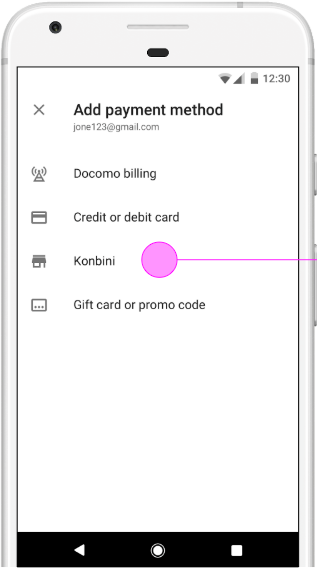
|
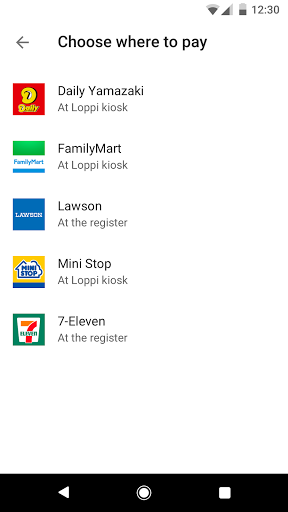
|
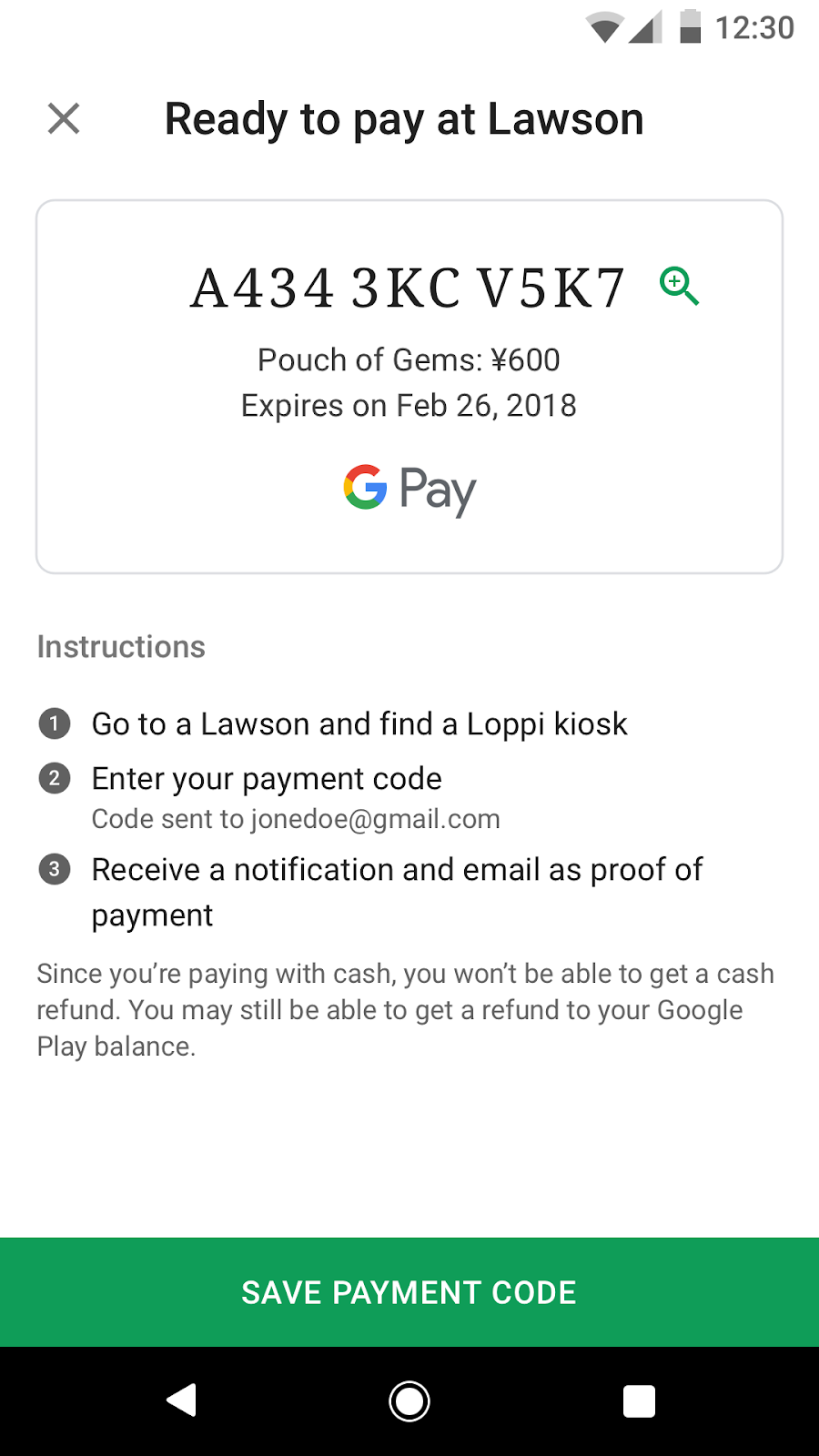
|
Concepts and terminology
符号和惯例
关键字“必须”“不得”“必需”“会”“不会”,“应该”“不应”“推荐”“可以”和“OPTIONAL”RFC 2119 中解释这些文档。
时间戳
所有时间戳均以自 Unix 纪元(1970 年 1 月 1 日)以来的毫秒数表示(采用世界协调时间)。
例如:
- 2019 年 4 月 23 日晚上 8:23:25(格林尼治标准时间 = 1556051005000 毫秒)
- 格林尼治标准时间 2018 年 8 月 16 日下午 12:28:35 = 1534422515000 毫秒
金额
此 API 中的货币值采用名为“微单位”的格式,是 Google 的一项标准微单位是一种基于整数的固定精度格式。要以微单位表示货币价值,请用标准货币价值乘以 1,000,000。
例如:
- 1.23 美元 = 1230000 微美元
- 0.01 美元 = 10000 微美元
幂等性
此 API 中的所有方法调用都必须具有幂等行为。Google 将不定期地重试请求,以确保双方的事务都处于相同的状态。集成商不应尝试重新处理任何已成功处理的请求。应改为报告成功处理的响应。所有方法都有一个共同的 RequestHeader,其中包含 requestId。此 requestId 是所有调用的幂等键。
任何非终端响应(非 HTTP 200 成功)不得以幂等方式进行处理。因此,之前收到 400(错误请求/失败前提条件)的请求在第二次调用时不得以幂等方式返回 400,必须重新评估该请求。在重新评估时,它可能会返回 400 或成功处理。
如需详细了解幂等性,请参阅此详细指南。
集成商
使用 Google 付款平台开展业务的公司。它可能是内部 (1P) 企业,如 YouTube 或 AdWords;也可能是希望将其服务与 Google 生态系统集成的外部 (3P) 企业。
付款方式
付款方式。这比乐器更通用。Visa、MasterCard 和 PayPal 均为付款方式。
乐器
特定客户使用的特定付款方式。例如用户的信用卡或 PayPal 账号。特定客户的令牌化 FOP 也是一种付款方式,因为它是该客户的付款方式实例,安全地存储在我们的系统中。
令牌
在 Google 系统中,表示特定用户的付款方式。令牌包含购买所需的全部信息,因此也是一种付款方式。这可能包括用户在集成商处拥有的账号等信息。
Key flows
Google uses two key flows to create and pay these reference numbers:
- Generate Reference Number Flow.
- Pay Reference Number Flow.
Later, reconciliation and settlement from resulting purchases are handled by the remittance flow.
The diagram below illustrates each of these flows.
Cash FOP overview
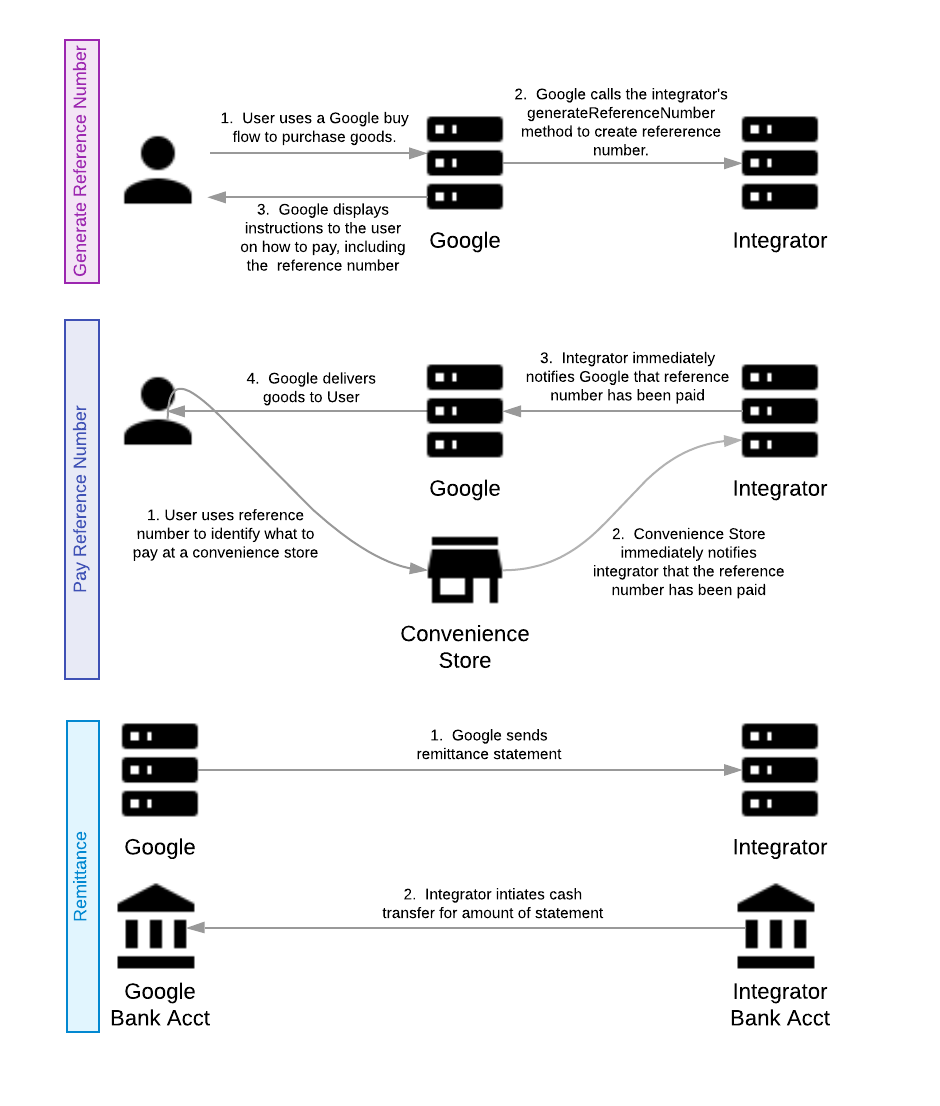
The first two flows are described in more detail in the following sections. See the Remittance flow page if you want to know more about that flow.
Generate reference number
The purpose of the generate reference number flow is to create and exchange an identifier (reference number) that both Google and the integrator can use to identify a purchase. The user can then use this reference number at a convenience store, kiosk, or bank to complete the purchase. This identifier is generated by the integrator at Google's request by calling the generateReferenceNumber method. The request for generation of the reference number includes an amount and a transaction description.
The following diagram illustrates how a reference number is generated and sent to the customer with instructions.
Generate reference number flow
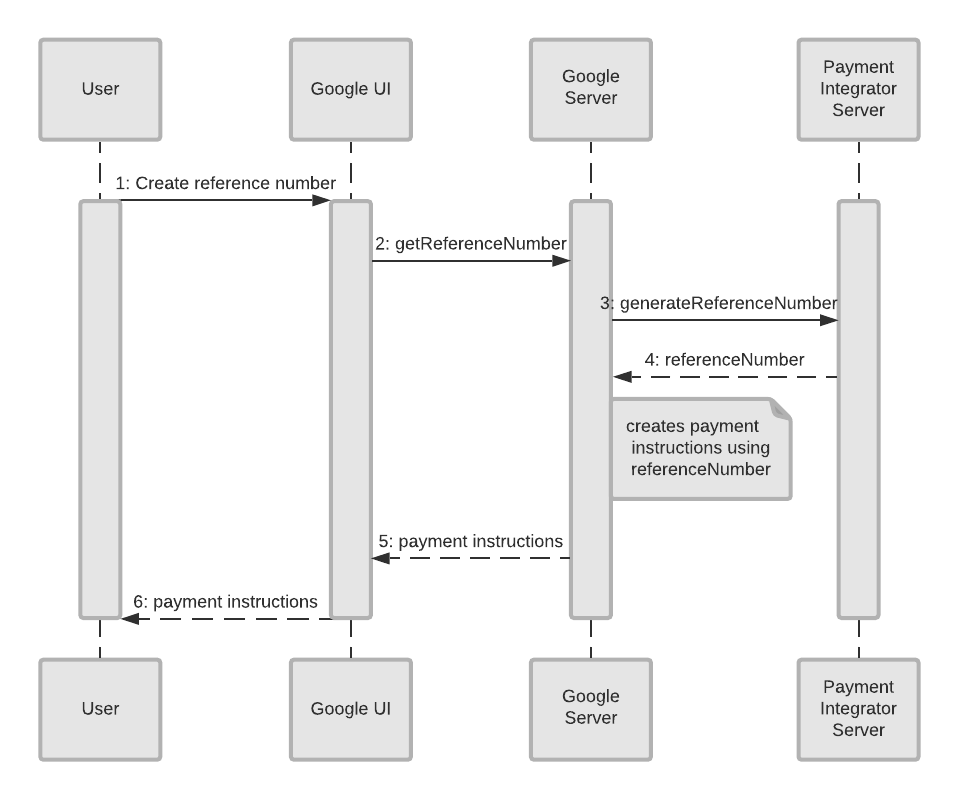
Here is a list of the objects and what they represent:
- User: This is the person who wants to pay for something using this form of payment.
- Google UI: This is the interface where the User makes their purchase. It could be through the web or through an app.
- Google Server: The backend server at Google that requests the generation of the reference number and creates payment instructions for the user.
- Payment Integrator Server: The backend server of the Payment Integrator that keeps track of the payment details and generates the reference number.
This flow begins with the user who wants to use this cash form of payment.
- The User accesses the Google UI which sends sends a request for a reference number.
- The Google UI sends a message to the Google Server that it needs a reference number (
getReferenceNumber). - The Google Server asks the Payment Integrator Server to generate a reference number (
generateReferenceNumber). - The Payment Integrator Server generates and sends the reference number to the Google Server.
- The Google Server creates payment instructions to go along with the reference number. Then it sends this information to the Google UI.
- The Google UI sends these instructions and reference number to the User.
Notes on reference numbers
Reference numbers can only be paid once, and they can be cancelled through the cancel reference number flow. Also, reference numbers must be alphanumeric, and it must support multiple display formats.
In addition to displaying the reference number, Google's UIs can optionally represent the reference number in the Code 128 format (a barcode format). Other barcode formats can be supported by request.
Pay Reference Number
The user will use this reference number at a convenience store, kiosk, or bank to identify the purchase the user wants to pay for. The integrator should have the user confirm the purchase being paid by displaying the purchase amount, date, and transaction description prior to paying.
Once the user chooses to pay, they must pay in full, and only pay once. This API does not support over or under payments on a single reference number. Multiple payments to a single reference number is also not supported.
Once the user pays, the integrator must immediately notify Google that this reference number has been paid via the referenceNumberPaidNotification
Once paid, the reference number and amount will be included in the remittance statement sent on T+2 days.
Here is a sequence diagram that illustrates the payment of a reference number.
Pay reference number flow
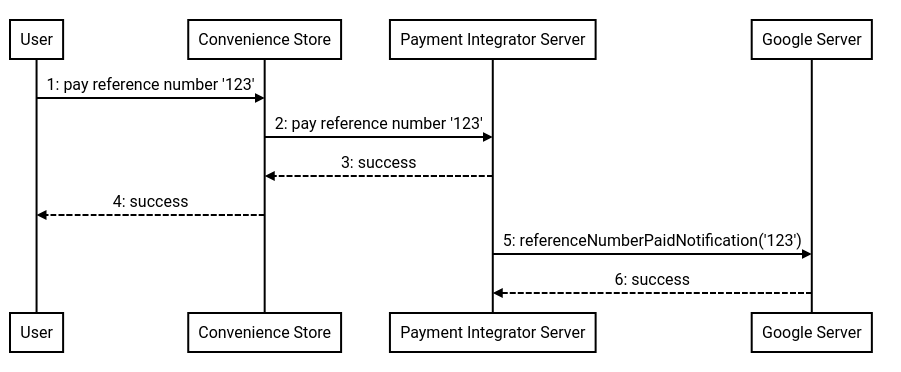
The objects in the diagram represent the following:
- User: This is the person who wants to pay for something using this form of payment.
- Convenience Store: The location where the user makes their payment using the reference number and instructions given, such as a convenience store.
- Payment Integrator Server: The backend server of the Payment Integrator that keeps track of the payment details.
- Google Server: The backend server at Google that requests the generation of the reference number and creates payment instructions for the user.
This flow begins with the user who goes to a convenience store in order to make a payment according to the instructions given to them.
- The User goes to a Convenience Store to make a payment.
- After the transaction is complete, the convenience store notifies the payment integrator of payment.
- The Payment Integrator Server sends a success message to the Convenience Store.
- The Convenience Store conveys that the transaction was a success to the User, and the goods will be delivered to the User soon.
- The Payment Integrator Server sends a message to Google’s Server that the reference number has been paid (
referenceNumberPaidNotification - The Google Server responds with a message of success to the Payment Integrator Server.
Cancel reference number
Reference numbers can be cancelled by Google. If Google cancels a reference number, the cancelReferenceNumber method will be called. Upon successful return of this call, it is invalid to pay that reference number, and the integrator must refuse payment for this number. Upon success of this call, all future calls to the referenceNumberPaidNotification
If the payment process has already started, for example if the user has entered their reference number into a kiosk but has not yet paid, the integrator should return a HTTP 423 response code with ErrorResponse containing [USER_ACTION_IN_PROGRESS][google.standardpayments.v1.ErrorResponse].
Refund
Paid reference numbers can be refunded by Google using the request ID of the original generateReferenceNumber call (note that refunds will NOT use the reference number). If Google refunds a reference number, the refund method will be called. This method can be called multiple times with amounts totalling less than or equal to the original paid amount.
Next: Remittance flow